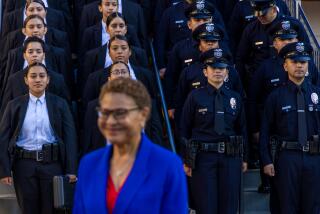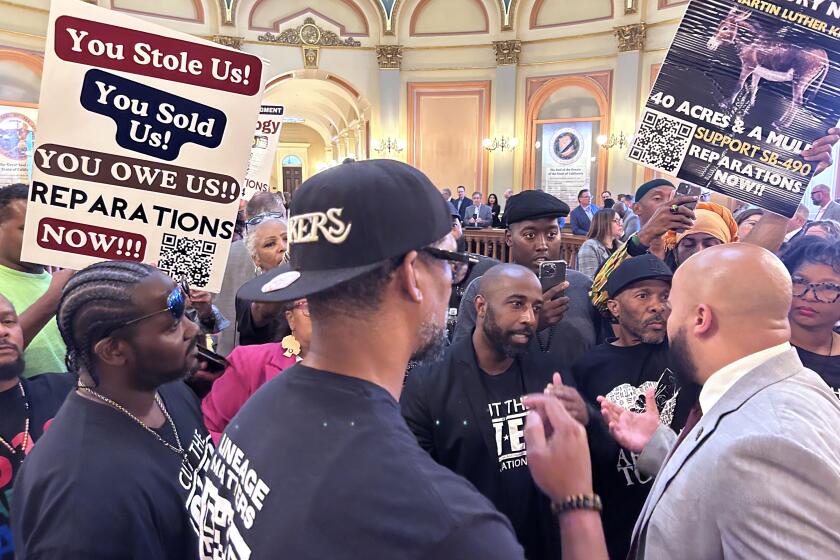Past Police Chiefs
- Share via
Los Angeles’ first chief of police--Jacob F. Gerkins--was appointed in 1876. Since then, there have been 48, including interim chiefs. Below are a few of those who preceded Chief Daryl F. Gates, who was appointed in 1978.
EDWARD M. DAVIS
Aug. 29, 1969, to Jan. 15, 1978
One of the department’s more flamboyant and outspoken leaders, Davis presided over the force during a time of sweeping social changes--changes that did not always meet his approval. For example, he said the women’s liberation movement could lead to “the use of dope, stealing, thieving and killing” among children whose mothers work. One of the most memorable incidents of his tenure was the police shootout with barricaded members of the Symbionese Liberation Army in 1974. Although perhaps best known for his stinging quotes, Davis brought massive reorganization to the department, decentralizing operations in an effort to make officers more responsive to local crime problems. On the press, Davis once said, “If my whole image was developed by the Los Angeles Times, people would run me out of town on a rail and tar and feather me in the process.”
THOMAS REDDIN
Feb. 18, 1967, to May 5, 1969
Reddin’s immediate concerns were crime, community relations and lack of manpower. Revamped recruiting procedures and decentralized candidate testing helped alleviate the critical personnel shortage. Civilian staffing was increased. The Police Student Worker Program began, encouraging men ages 18 to 21 to work part time for the LAPD during the school year and full time during the summer. They performed non-enforcement patrol, detective, traffic, juvenile, jail and staff functions and were encouraged to complete the examination to become officers.
WILLIAM H. PARKER
Served Aug. 9, 1950, to July 16, 1966
Parker served 16 years, the longest term of any Los Angeles police chief. The department’s main headquarters in downtown Los Angeles is named in his honor. Among other things, Parker consolidated the city and county jail systems and brought more specialization to detective units. Parker was widely credited with cracking down on corruption within the LAPD, though his detractors say he encouraged brutality among his officers. The Watts riots in 1965 occurred during the tenure of Parker, who said of the uprising: “One person threw a rock, and then, like monkeys in a zoo, others started throwing rocks.”
CLEMENCE B. HORRALL
June 16, 1941, to June 28, 1949
Six months into his tenure, Horrall was indicted by a grand jury, along with other top city officials, after wiretapping equipment was found in City Hall. The charges were soon dismissed when the trial judge discovered a penal code section permitting use of Dictographs by police officers. Horrall’s time in office included such events as the zoot suit riots in East Los Angeles in 1942 and the still unsolved “Black Dahlia” murder of 22-year-old Elizabeth Short in 1947.
ARTHUR H. HOHMANN
June 24, 1939, to June 5, 1941
Hohmann came into the chief’s office with an unblemished record, no political friends and a strict set of moral principles. He resigned after two years, in part because of the North American Aviation labor strike and riot. Before the strike, the department had been openly allied with business and management in labor disputes, but Hohmann resented the use of police to break strikes. North American Aviation management expected the police to break up and disperse the strikers but Hohmann ordered officers not to intervene. Finally, when disorder occurred, the 15th U.S. Infantry stepped in and a riot followed. Newspapers, particularly The Times, condemned the department. This, plus the death of his son in an accident, prompted Hohmann to resign.
SOURCES: “From Posses to Professionals--A History of the Los Angeles Police Department” by Arthur W. Sjoquist; “Los Angeles Police Department 1869-1984” published by the Los Angeles Police Revolver and Athletic Club, and articles from The TimesCompiled by researcher Tracy Thomas
More to Read
Sign up for Essential California
The most important California stories and recommendations in your inbox every morning.
You may occasionally receive promotional content from the Los Angeles Times.










